Photoreactive UV-Crosslinkable Acrylic Pressure-Sensitive Adhesives (PSA) Containing Multifunctional Photoinitiators
Abstract
:1. Introduction
2. Materials and Methods
2.1. Basic Acrylic PSA
- Amount of solid materials 50 wt.%
- Viscosity 10.3 Pa·s
- Concentration of residual monomers <0.2 wt.%
- Weight average molecular weight MW 621,000 Da
- Number average molecular weight Mn 214,000 Da
- Polydispersity Pd = MW/Mn 2.90
2.2. Investigated Photoinitiators Type I (α-Cleavage) and Type II (H-Abstractors)
3. Results and Discussion
4. Conclusions
- There is a clear dependence of shear strength of UV-crosslinked acrylic PSA on photoinitiator concentration.
- The increase of the photoinitiator concentration reduces the tack of UV-crosslinked acrylic adhesives, the peel adhesion reaches the maximum at about 0.6 wt.% of type II photoinitiator of tris-benzophenyloxy phosphineoxide (TBPO).
- From the examined multifunctional hydrogen atom abstractors, the best performances were noticed in the case of the type II photoinitiator of tris-benzophenyloxy phosphineoxide (TBPO). Comparative studies between the UV-crosslinked acrylic PSA containing the selected photoinitiators type II and TBPO showed a little superiority of the UV-crosslinkable basic self-adhesive containing tris-benzophenyloxy phosphineoxide.
- The UV-crosslinkable acrylic PSA containing TBPO can be used for manufacturing of self-adhesive materials in form of mounting tapes, masking tapes or wide range of sign and marking films.
Author Contributions
Funding
Institutional Review Board Statement
Informed Consent Statement
Data Availability Statement
Conflicts of Interest
References
- Handbook of Pressure Sensitive Adhesive Technology; Satas, D. (Ed.) Springer: Boston, MA, USA, 1989; ISBN 978-1-4757-0868-4. [Google Scholar]
- Kunwong, D.; Sumanochitraporn, N.; Kaewpirom, S. Curing behavior of a UV-curable coating based on urethane acrylate oligomer: The influence of reactive monomers. Songklanakarin J. Sci. Technol. 2011, 33, 201–207. [Google Scholar]
- Hilmi Mahmood, M.; Abdullah, Z.; Sakurai, Y.; Zaman, K.; Dahlan, M.H. Effects of monomers on the properties of palm-oil-based radiation curable pressure sensitive adhesives (PSA)—A prepolymer method. Radiat. Phys. Chem. 2001, 60, 129–137. [Google Scholar] [CrossRef]
- Tugiman, N.B.; Rahmat, A.R.; Jamaluddin, J.; Tajulruddin, W.N.W.; Mustapha, R. Preliminary study on degree of conversion of uv curable maleinated acrylated epoxidised palm oil pressure sensitive adhesives synthesised with isobornyl methacrylate monomer via FTIR-ATR analysis. Chem. Eng. Trans. 2017, 56, 223–228. [Google Scholar] [CrossRef]
- Decker, C.; Zahouily, K.; Decker, D.; Nguyen, T.; Viet, T. Performance analysis of acylphosphine oxides in photoinitiated polymerization. Polymer 2001, 42, 7551–7560. [Google Scholar] [CrossRef]
- Czech, Z.; Butwin, A.; Kabatc, J. Photoreactive UV-crosslinkable acrylic pressure-sensitive adhesives containing type-II photoinitiators. Eur. Polym. J. 2011, 47, 225–229. [Google Scholar] [CrossRef]
- Czech, Z.; Kowalczyk, A.; Kabatc, J.; Świderska, J. Photoreactive UV-crosslinkable solvent-free acrylic pressure-sensitive adhesives containing copolymerizable photoinitiators based on benzophenones. Eur. Polym. J. 2012, 48, 1446–1454. [Google Scholar] [CrossRef]
- Kabatc, J.; Czech, Z.; Kowalczyk, A. The application of halomethyl 1,3,5-triazine as a photoinitiator or co-initiator for acrylate monomer polymerization. J. Photochem. Photobiol. A Chem. 2011, 219, 16–25. [Google Scholar] [CrossRef]
- Kabatc, J.; Zadrużyńska, A.; Czech, Z.; Kowalczyk, A. The synthesis, spectroscopic and electrochemical properties, and application of new dyeing photoinitiator systems for acrylate monomers polymerization. Dye. Pigment. 2012, 92, 724–731. [Google Scholar] [CrossRef]
- Dietliker, K.; Hüsler, R.; Birbaum, J.L.; Ilg, S.; Villeneuve, S.; Studer, K.; Jung, T.; Benkhoff, J.; Kura, H.; Matsumoto, A.; et al. Advancements in photoinitiators-Opening up new applications for radiation curing. Prog. Org. Coat. 2007, 58, 146–157. [Google Scholar] [CrossRef]
- Czech, Z.; Shao, L.; Kowalczyk, A.; Kabatc, J.; Cheng, X.-Q.; Świderska, J. Photocrosslinking of solvent-based acrylic pressure-sensitive adhesives (PSA) by the use of selected photoinitiators type I. J. Adhes. Sci. Technol. 2013, 27, 2398–2410. [Google Scholar] [CrossRef]
- Czech, Z.; Kabatc, J.; Kowalczyk, A.; Sowa, D.; Madejska, E. Application of selected 2-methylbenzothiazoles AS cationic photoreactive crosslinkers for pressure-sensitive adhesives based on acrylics. Int. J. Adhes. Adhes. 2015, 58, 1–6. [Google Scholar] [CrossRef]
- Dumur, F. Recent advances on carbazole-based photoinitiators of polymerization. Eur. Polym. J. 2020, 125, 109503. [Google Scholar] [CrossRef]
- Mitterbauer, M.; Knaack, P.; Naumov, S.; Markovic, M.; Ovsianikov, A.; Moszner, N.; Liska, R. Acylstannanes: Cleavable and Highly Reactive Photoinitiators for Radical Photopolymerization at Wavelengths above 500 nm with Excellent Photobleaching Behavior. Angew. Chem. Int. Ed. 2018, 57, 12146–12150. [Google Scholar] [CrossRef] [PubMed]
- Dietlin, C.; Trinh, T.T.; Schweizer, S.; Graff, B.; Morlet-Savary, F.; Noirot, P.A.; Lalevée, J. New phosphine oxides as high performance near-UV type I photoinitiators of radical polymerization. Molecules 2020, 25, 1671. [Google Scholar] [CrossRef] [Green Version]
- Chen, S.; Jin, M.; Malval, J.-P.; Fu, J.; Morlet-Savary, F.; Pan, H.; Wan, D. Substituted stilbene-based oxime esters used as highly reactive wavelength-dependent photoinitiators for LED photopolymerization. Polym. Chem. 2019, 10, 6609–6621. [Google Scholar] [CrossRef]
- Li, Z.; Zou, X.; Shi, F.; Liu, R.; Yagci, Y. Highly efficient dandelion-like near-infrared light photoinitiator for free radical and thiol-ene photopolymerizations. Nat. Commun. 2019, 10, 3560. [Google Scholar] [CrossRef] [Green Version]
- Czech, Z.; Kabatc, J.; Ragańska, P.; Jurek, K. 2-Methylbenzothiazolium derivatives as cationic photoreactive crosslinker for acrylic pressure-sensitive adhesives containing oxirane groups from glycidyl methacrylate. Int. J. Adhes. Adhes. 2018, 80, 39–42. [Google Scholar] [CrossRef]
- Benedek, I. Pressure-Sensitive Adhesives and Applications, 2nd ed.; Marcel Dekker, Inc.: New York, NY, USA; Basel, Switzerland, 2004. [Google Scholar]
- Park, S.H.; Lee, T.H.; Park, Y.I.; Noh, S.M.; Kim, J.C. Effect of the n -butyl acrylate/2-ethylhexyl acrylate weight ratio on the performances of waterborne core–shell PSAs. J. Ind. Eng. Chem. 2017, 53, 111–118. [Google Scholar] [CrossRef]
- Jovanović, R.; Dubé, M.A. Emulsion-Based Pressure-Sensitive Adhesives: A Review. J. Macromol. Sci. Part. C Polym. Rev. 2004, 44, 1–51. [Google Scholar] [CrossRef]
- Lee, S.W.; Park, J.W.; Park, C.H.; Kim, H.J.; Kim, E.A.; Woo, H.S. Optical properties and adhesion performance of optically clear acrylic pressure sensitive adhesives using chelate metal acetylacetonate. Int. J. Adhes. Adhes. 2013, 47, 21–25. [Google Scholar] [CrossRef]
- Noori, H.; Jain, M.; Nielsen, K.; Brandys, F. Delamination in deformed polymer laminated sheet metals. Int. J. Adhes. Adhes. 2018, 85, 219–224. [Google Scholar] [CrossRef]
- Czech, Z. Crosslinking of pressure sensitive adhesive based on water-borne acrylate. Polym. Int. 2003, 52, 347–357. [Google Scholar] [CrossRef]
- Zhang, X.; He, J.; Yue, L.; Bai, Y.; Liu, H. Heat resistance of acrylic pressure-sensitive adhesives based on commercial curing agents and UV/heat curing systems. J. Appl. Polym. Sci. 2019, 136, 47310. [Google Scholar] [CrossRef]
- Baek, S.S.; Hwang, S.H. Eco-friendly UV-curable pressure sensitive adhesives containing acryloyl derivatives of monosaccharides and their adhesive performances. Int. J. Adhes. Adhes. 2016, 70, 110–116. [Google Scholar] [CrossRef]
- Kajtna, J.; Krajnc, M. UV crosslinkable microsphere pressure sensitive adhesives-influence on adhesive properties. Int. J. Adhes. Adhes. 2011, 31, 29–35. [Google Scholar] [CrossRef]
- Zhu, M.; Cao, Z.; Zhou, H.; Xie, Y.; Li, G.; Wang, N.; Liu, Y.; He, L.; Qu, X. Preparation of environmentally friendly acrylic pressure-sensitive adhesives by bulk photopolymerization and their performance. RSC Adv. 2020, 10, 10277–10284. [Google Scholar] [CrossRef]
- Kim, J.-S.; Shim, G.-S.; Baek, D.; Back, J.-H.; Jang, S.-W.; Kim, H.-J.; Choi, J.-S.; Yeom, J.-S. UV/UV step-curing of optically clear acrylate adhesives for mobile devices. Express Polym. Lett. 2019, 13, 794–805. [Google Scholar] [CrossRef]
- Baek, S.S.; Jang, S.J.; Hwang, S.H. Preparation and adhesion performance of transparent acrylic pressure sensitive adhesives: Effects of substituent structure of acrylate monomer. Int. J. Adhes. Adhes. 2016, 64, 72–77. [Google Scholar] [CrossRef]
- Czech, Z.; Kabatc, J.; Bartkowiak, M.; Licbarski, A.; Mozelewska, K.; Kwiatkowska, D. Novel photoreactive pressure-sensitive adhesives (PSA) based on acrylics containing additionable photoinitiators. Materials 2020, 13, 5151. [Google Scholar] [CrossRef]


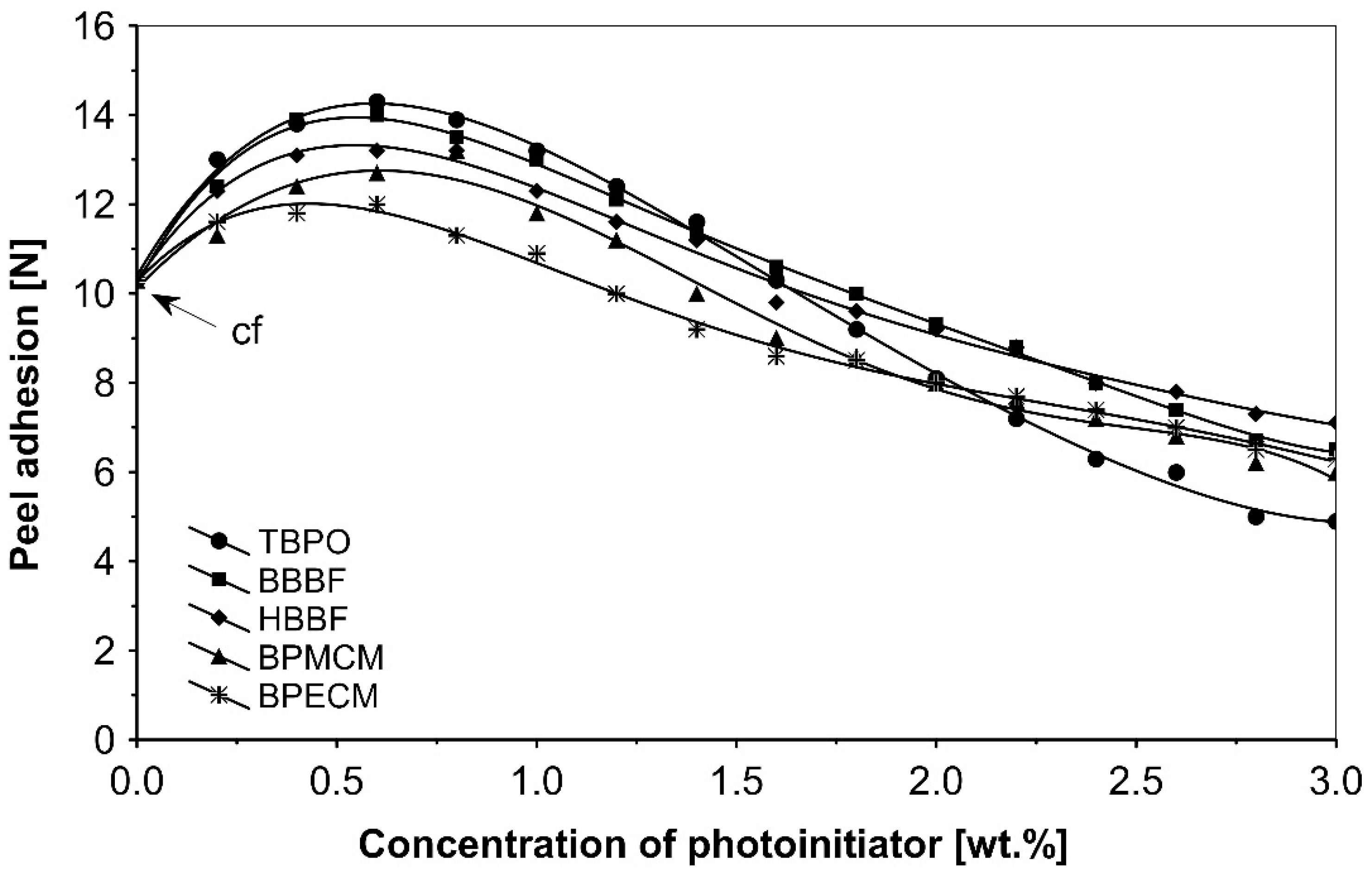
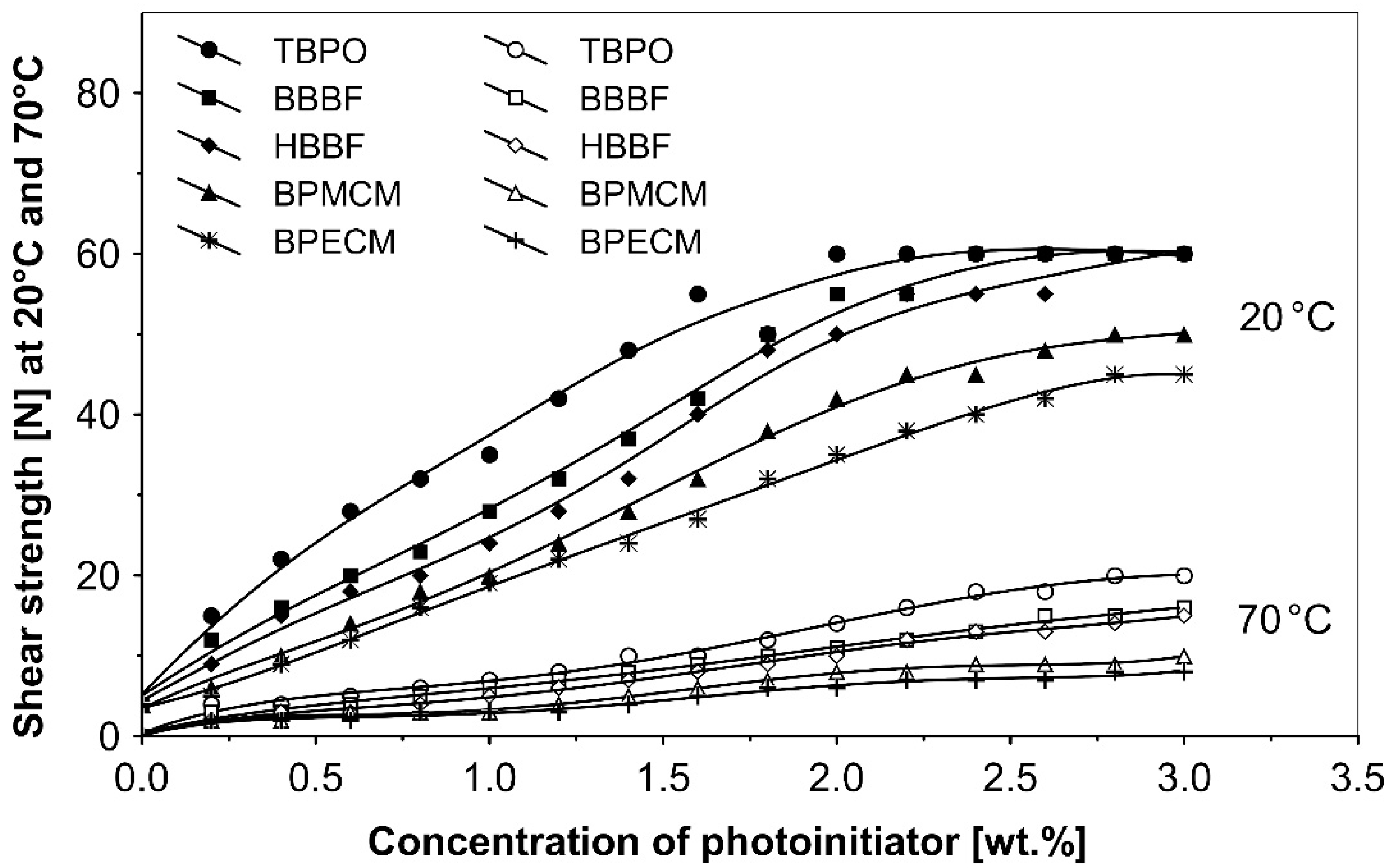
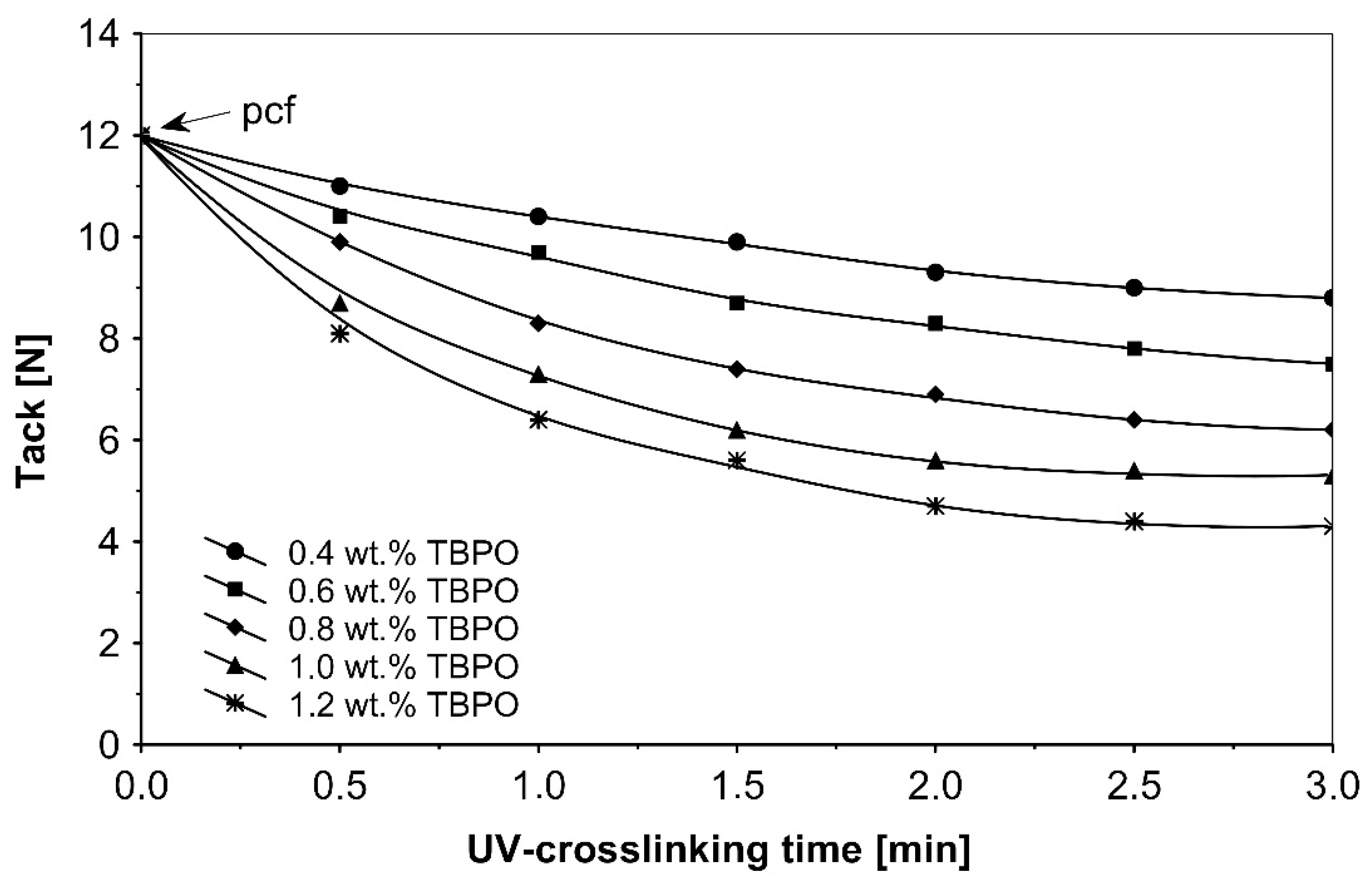
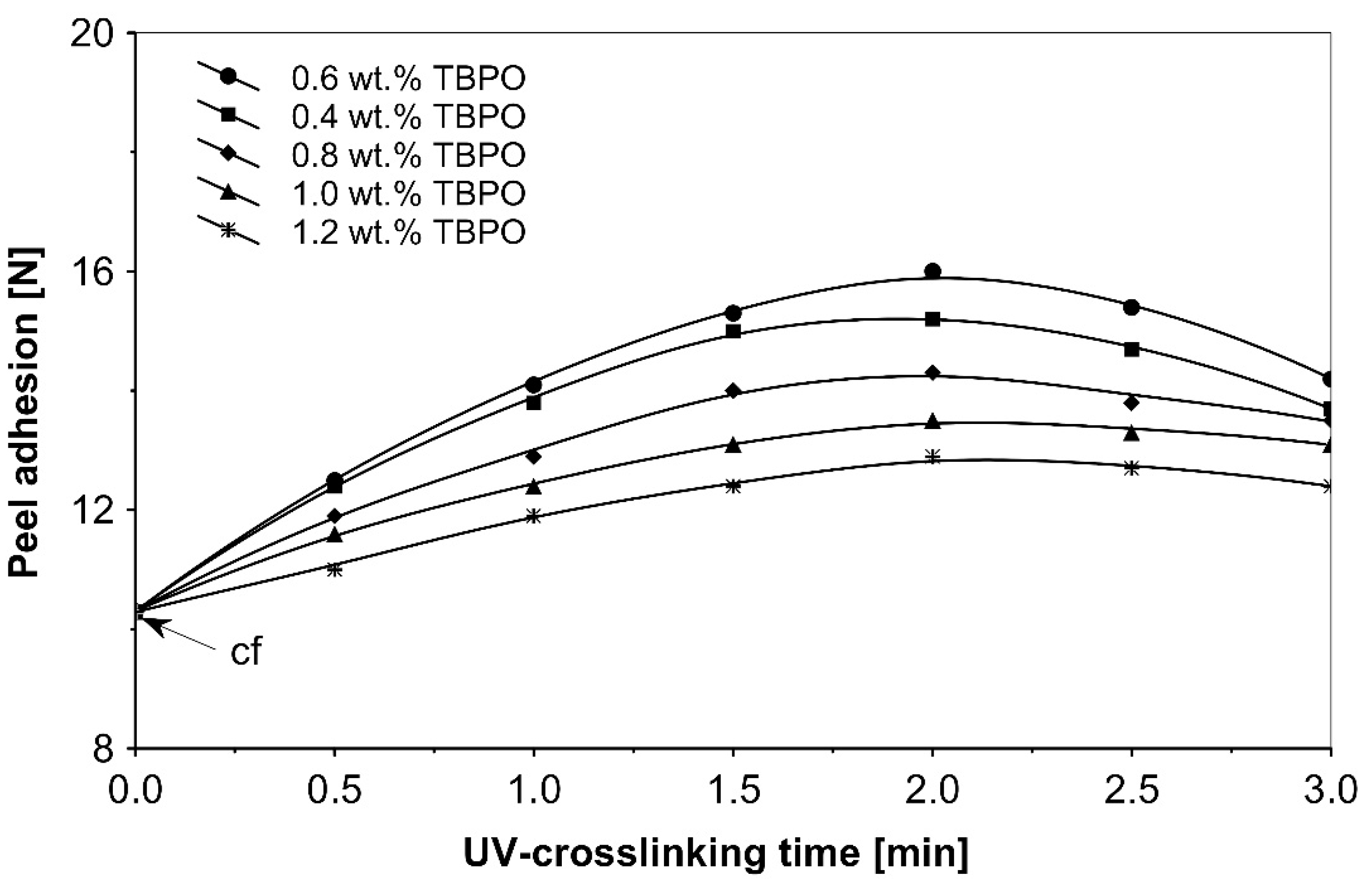

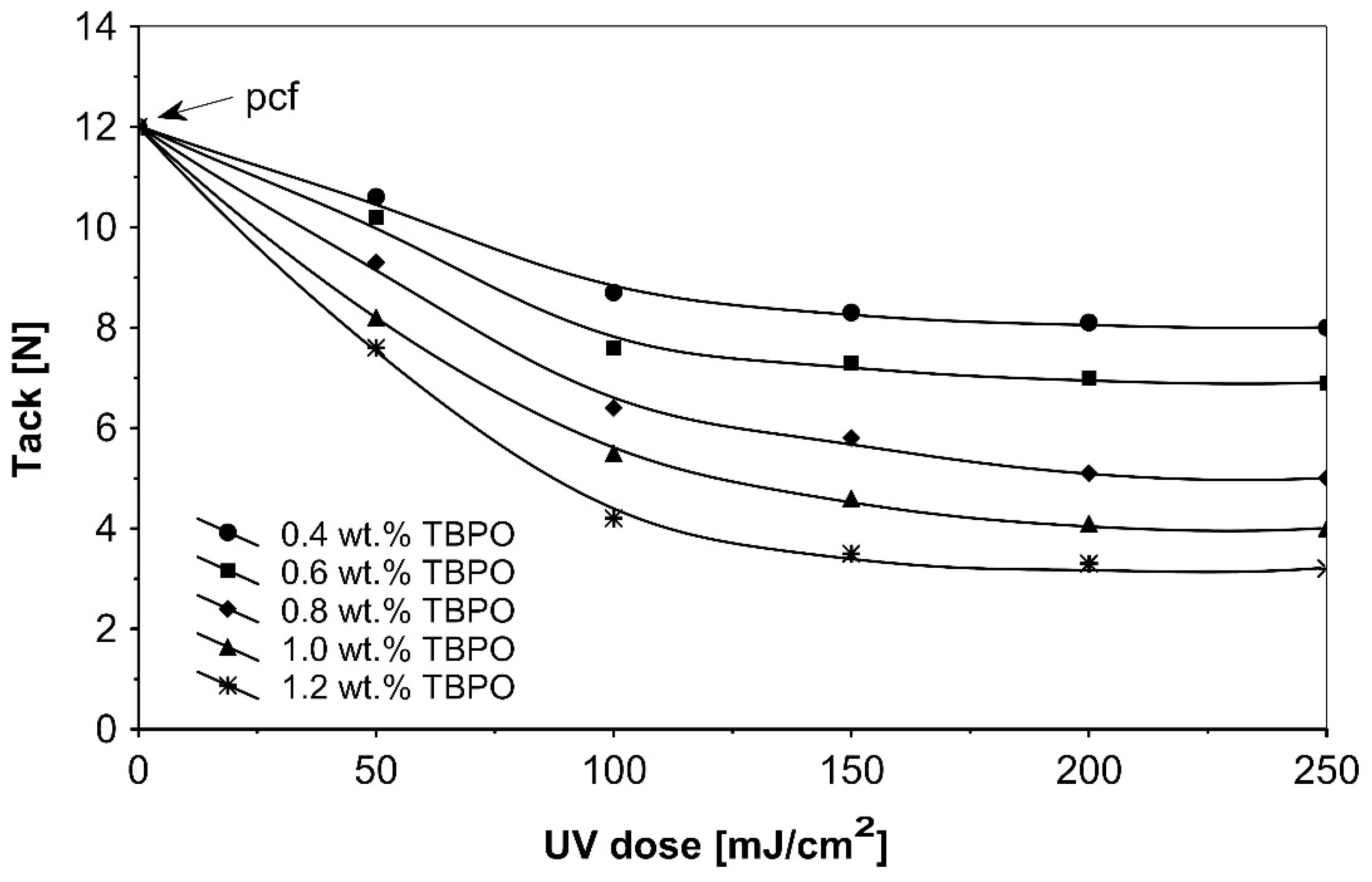
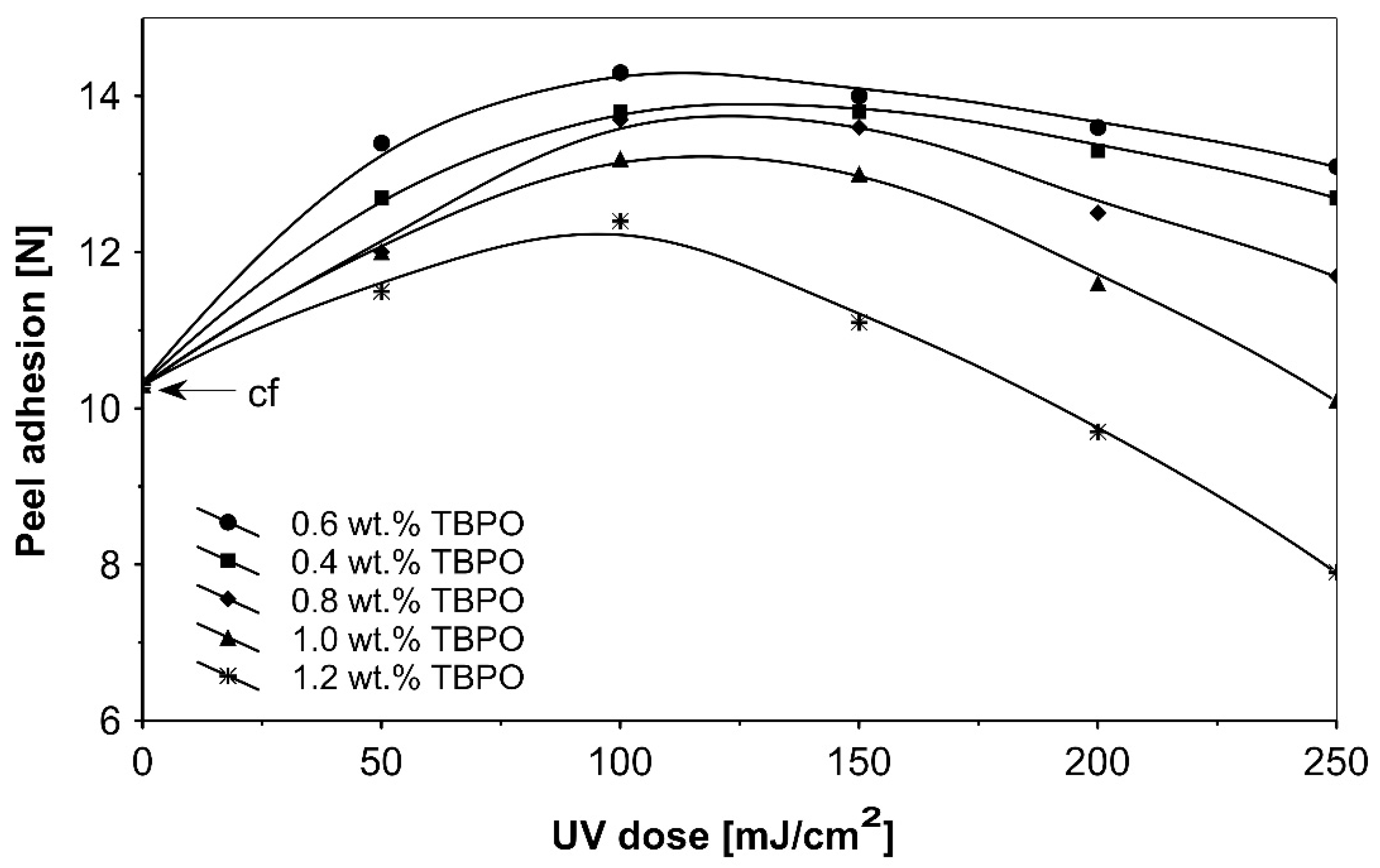

| Photoinitiator | Chemical Formula | Chemical Name |
|---|---|---|
| BPMCM |  | Bis-[2-(2-hydroxy-2-methyl-propione-1-one)phenylmethylene carbamyl] methylene |
| BPECM |  | Bis-[4-(2-hydroxy-2-methyl-propione-1-one)phenylethylenecarbamyl] methylene |
| BBBF |  | Butanediol-1,4-bis-benzophenoxyformiate |
| HBBF | 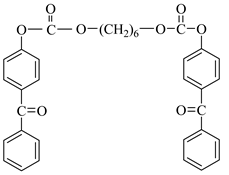 | Hexanediol-1,6-bis-benzophenoxyformiate |
| TBPO |  | Tris-benzophenyloxy phosphineoxide |
Publisher’s Note: MDPI stays neutral with regard to jurisdictional claims in published maps and institutional affiliations. |
© 2021 by the authors. Licensee MDPI, Basel, Switzerland. This article is an open access article distributed under the terms and conditions of the Creative Commons Attribution (CC BY) license (https://creativecommons.org/licenses/by/4.0/).
Share and Cite
Bartkowiak, M.; Czech, Z.; Kim, H.-J.; Shim, G.-S.; Nowak, M.; Antosik, A.K. Photoreactive UV-Crosslinkable Acrylic Pressure-Sensitive Adhesives (PSA) Containing Multifunctional Photoinitiators. Polymers 2021, 13, 4413. https://doi.org/10.3390/polym13244413
Bartkowiak M, Czech Z, Kim H-J, Shim G-S, Nowak M, Antosik AK. Photoreactive UV-Crosslinkable Acrylic Pressure-Sensitive Adhesives (PSA) Containing Multifunctional Photoinitiators. Polymers. 2021; 13(24):4413. https://doi.org/10.3390/polym13244413
Chicago/Turabian StyleBartkowiak, Marcin, Zbigniew Czech, Hyun-Joong Kim, Gyu-Seong Shim, Małgorzata Nowak, and Adrian Krzysztof Antosik. 2021. "Photoreactive UV-Crosslinkable Acrylic Pressure-Sensitive Adhesives (PSA) Containing Multifunctional Photoinitiators" Polymers 13, no. 24: 4413. https://doi.org/10.3390/polym13244413
APA StyleBartkowiak, M., Czech, Z., Kim, H.-J., Shim, G.-S., Nowak, M., & Antosik, A. K. (2021). Photoreactive UV-Crosslinkable Acrylic Pressure-Sensitive Adhesives (PSA) Containing Multifunctional Photoinitiators. Polymers, 13(24), 4413. https://doi.org/10.3390/polym13244413








